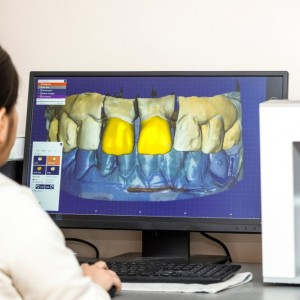
Thickness of lithium silicate crowns reinforced with zirconia: the effect on failure modes, survival rate
Simona Chirico
Despite the broad use of lithium disilicate systems, in recent years there are new developments with a more reliable glass-ceramic with further increased strength by microstructure reinforcement. Zirconia-reinforced lithium silicate (ZLS) system features a complex microstructure, which is composed of lithium-metasilicate, and lithium orthophosphate crystals embedded in a glassy matrix containing zirconia. The very fine crystal size exhibited in the ZLS system (0.5–1.0 m), which is approximately 4–6 times smaller than LD crystals (2.0–3.0 m), provides a higher percentage of glass content (roughly 50%) than LD (30%). This microstructure also supports exceptional optical properties with similar and higher mean translucency values compared to feldspar blocks and LD. Despite the higher glass content, the homogeneous dispersion of zirconia in the vitreous matrix increases the mechanical properties of the ceramic structure through solidification mechanisms, so much so that the ZLS ceramic discs have shown a significantly greater flexural strength than LD systems.
Materials and methods
In an in vitro study by Bergamo and his team, the authors assessed the reliability and the degree of failure of monolithic ZLS molar crowns with different thickness using the SSALT test. The authors fabricated, modelled and milled 63 monolithic ZLS molar crowns with a thickness of 0.5 mm, 1.0 mm and 1.5 mm respectively (n = 21 / group) using a CAD / CAM system. Crowns were cemented on dentin-like epoxy resin replicas with a resin cement. The specimens were subjected to single load-to-failure test for step-stress profiles designing. Mouth-motion step-stress accelerated-life test was performed under water by sliding an indenter 0.7 mm lingually down on the disto-buccal cusp until specimen fracture or suspension. Use level probability Weibull curves and reliability were calculated and plotted. Polarized-light optical microscope and scanning electron microscope (SEM) were used to characterize fracture patterns.
Results
While 0.5 mm ZLS crowns exhibited a significant reduction in the probability of survival at 200 N, 300 N and 400 N mission loads (69%, 41% and 19%, respectively), no significant difference was observed between 1.0 mm and 1.5 mm crowns. Both thicknesses have maintained the survivability at approximately 90%. Failure primarily comprised bulk fracture where radial cracks originated from the cementation surface beneath the indenter loading trail and propagated towards the cervical margin.
Conclusions
The monolithic 1.5 mm and 1.0 mm thick ZLS crowns have a higher probability of survival than the 0.5 mm thick crowns. Bulk fracture was the chief failure mode, regardless of thickness.
Bergamo ETP, Bordin D, Ramalho IS, Lopes ACO, Gomes RS, Kaizer M, Witek L, Bonfante EA, Coelho PG, Del Bel Cury AA. "Zirconia-reinforced lithium silicate crowns: Effect of thickness on survival and failure mode." Dent Mater. 2019 Jul; 35 (7): 1007-1016. DOI: 10.1016/j.dental.2019.04.007
 Related articles
Related articles
Prosthodontics 30 June 2025
Prosthodontic rehabilitation in the maxillary area using zirconia dental implants: a case report.
Purpose: Zirconia (ZrO2) is a ceramic material with adequate mechanical properties for manufacturing of medical devices. Zirconia stabilized with Y2O3 has the best properties for these applications.
Bioceramics are ceramic compounds obtained both in situ and in vivo, by various chemical processes.
Products 28 October 2024
Barings Supports Zabel’s New Platform Investment in Golden Ceramic Dental Lab
Barings, one of the world’s leading investment managers, today announced that it has served as the lead agent, sole lender, and minority equity investor to provide financing support for The Zabel...
Endodontics 21 August 2024
Bioceramics are materials which include Alumina, Zirconia, Bioactive glass, Glass ceramics, Hydroxyapatite, resorbable Calcium phosphates, among others.
News 16 August 2024
Dinesh Sinha, BDS, PhD, interviews Nathaniel C. Lawson, DMD, PhD, director of the division of biomaterials at the University of Alabama at Birmingham School of Dentistry, about the strength testing...
 Read more
Read more
Much like EMTs rushing to the scene after an accident, stem cells hurry to the site of a skull fracture to start mending the damage. A new finding has uncovered the signaling mechanism that triggers...
Products 05 November 2025
SimplyTest has launched a groundbreaking saliva-based test to detect high-risk strains of oral human papillomavirus (HPV), a major cause of oropharyngeal cancers.
News 05 November 2025
Perimetrics, Inc., a dental technology company pioneering quantitative diagnostics, announced today that the U.S. Food and Drug Administration (FDA) has granted clearance for the InnerView...
News 05 November 2025
On October 15, open enrollment for Medicare began nationwide. Hundreds of thousands of seniors in New Jersey will once again face the challenge of finding the right Medicare coverage, including the...
Digital Dentistry 04 November 2025
Digitalisation is an expanding field in dentistry and implementation of digital teaching methods in dental education is an essential part of modern education.















